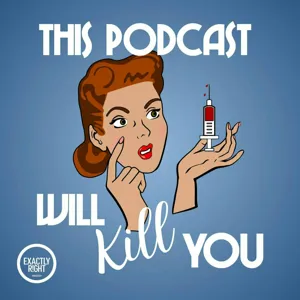Podcast Summary
Discovering the Deadly Impact of Hookworms: In the early 20th century, the discovery of hookworms and their complex life cycle led to widespread fear and panic, but also important advancements in public health and sanitation.
The discovery of hookworms and their impact on public health was a sudden and alarming revelation in the early 20th century. The parasites, which could enter the body through bare feet or even ingestion, were portrayed as deadly enemies that could cause serious health issues. The hookworm, specifically the species Ancylostoma duodenale, had a complex life cycle involving larvae burrowing into the skin or being ingested, leading to infection. This discovery led to widespread fear and panic, but also to important advancements in public health and sanitation. The hookworm is just one example of the many fascinating and often overlooked parasites that exist in our world. So, the next time you're enjoying a drink like our "dew poison" quarantini, take a moment to appreciate the intricacies of these tiny organisms and the important role they play in our ecosystems.
From Soil to Bloodstream: The Life Cycle of Hookworms: Hookworms start as eggs in soil, hatch into larvae, infect a host, travel to lungs, and attach to esophagus, causing health issues like anemia and stunted growth if left untreated. Prevent infections by wearing shoes in endemic areas.
Hookworms start as unassuming eggs in the soil, hatching into tiny larvae that feed on soil microbes. However, once they reach the L3 stage, they become dangerous and wait for a host to burrow into their skin and enter the bloodstream. They then travel to the lungs, burst out of the alveoli, and make their way to the esophagus where they attach and mate. The entire process from infection to adulthood takes between 5-9 weeks. Initially, an infected person may experience a ground itch or redness at the site of infection, but many infections are asymptomatic. Hookworms can cause significant health issues if left untreated, including anemia and stunted growth in children. It's important to be aware of the risks and take precautions to prevent infection, such as wearing shoes in areas where hookworms are common.
Hookworm infections cause damage to lungs and gut, leading to health issues and potential re-infection from soil.: Hookworms can cause damage to lungs and gut, leading to health issues like cough, pneumonitis, diarrhea, and intestinal upset. Re-infection from contaminated soil can lead to significant blood loss and potential anemia.
Hookworm infections, while often asymptomatic, can lead to significant health issues if left untreated due to the large number of eggs produced by the worms and the resulting high parasite burden. The worms cause damage to the lungs and gut, leading to symptoms like cough, pneumonitis, diarrhea, and intestinal upset. However, the real danger comes from the large number of eggs produced by the worms in contaminated soil, leading to constant re-infection and potentially life-threatening blood loss. This can result in iron deficiency anemia if the body's iron stores are depleted and unable to produce new blood. It's important to note that the smaller worms take less blood than the larger ones, but even a small number of worms can lead to significant blood loss and health issues with a high parasite burden.
Hookworms and iron deficiency anemia: Hookworms can cause anemia leading to growth retardation, cognitive impairments, and lifelong health issues. Their ability to evade the immune system results in long-term infections. The hygiene hypothesis suggests they may prevent autoimmune diseases, and intentional infections are explored as a treatment.
Hookworm infections can lead to iron deficiency anemia, which can have serious consequences for individuals, particularly children, resulting in growth retardation, cognitive impairments, and lifelong health issues. Hookworms are particularly adept at evading the human immune system, leading to long-term infections. The hygiene hypothesis suggests that the absence of parasitic worms, including hookworms, in wealthy nations may contribute to the rise of autoimmune diseases, and some research explores the potential of intentional hookworm infections as a treatment for certain autoimmune disorders. Overall, understanding the complex relationship between hookworms and human health is crucial for developing effective prevention and treatment strategies.
Ancient evidence suggests humans brought hookworms from Asia during early migrations: Ancient fossils reveal humans had hookworms during early migrations from Asia, but clinical trials haven't proven their benefit in reducing symptoms of autoimmune diseases
Ancient evidence, such as fossilized hookworm eggs and mummified hookworm bodies, found in archaeological sites in North and South America, suggests that humans brought these parasites with them during early migrations from Asia. The discovery of these worms provides valuable insights into the history of this parasitic relationship, which is believed to be quite ancient. However, while there is evidence that hookworms can reduce symptoms of hyper inflammatory autoimmune diseases in animal studies, clinical trials have not been successful. The idea that prior exposure to worms may prevent or lessen the likelihood of developing these diseases is an intriguing area of ongoing research.
Discovering Hookworm Fossils Before Columbus Challenges Early Human Migration Theories: The discovery of hookworm fossils in the Americas before Columbus' arrival challenges traditional beliefs about early human migration routes, suggesting an alternative Pacific coast pathway. However, the validity of these findings is debated due to questions about fossil identification and dating methods.
The discovery of hookworm fossils in the Americas before Columbus' arrival challenges long-held beliefs about the migration patterns of early humans. Hookworms require specific environmental conditions to develop and are primarily found in tropical and temperate zones. This raises questions about how hookworms could have been brought over the Beringia land bridge, as the climate in more northern areas is not suitable for their survival. Some researchers argue that these findings could suggest an alternative migration route along the Pacific coast. However, the validity of these discoveries is debated, with some researchers questioning the identification of the fossils as hookworms and the accuracy of the dating methods. Ancient DNA analysis could potentially provide answers, but its success rates are low and the precious samples may not be destroyed for the procedure. Additionally, studies of modern hookworm distributions support the possibility of pre-Columbian hookworms in the Americas. Overall, this discovery has significant implications for our understanding of early human migration patterns.
Ancient texts hinted at hookworm infections, but formal identification came later: Hookworms, causing health issues since ancient times, were formally identified in the late 1800s, with early discoveries leading to successful treatments.
Hookworms, a parasitic worm that causes significant health issues, were likely prevalent throughout human history despite not being formally identified until the late 1800s. Ancient texts from Egypt and Greece mention symptoms that could potentially be linked to hookworm infections, such as intestinal distress, anemia, and geophagy. The first recorded identification of hookworms came from an Italian physician named Angelo Dubini in 1838, who named them "hookworms" due to their distinct mouth and attachment structures. However, it wasn't until the late 1800s that the connection between hookworms and the diseases they cause was fully understood. For instance, during an outbreak of anemia among miners in Italy in 1880, researchers discovered over 1,500 hookworms in the stool of a single miner, leading to the development of a successful treatment just one year later. Despite early discoveries, many aspects of hookworm biology and transmission were still unknown, making the study of this parasite a complex and ongoing process.
Discovering Hookworm Transmission: A Long and Challenging Process: Arthur Luce's discovery of hookworm's percutaneous transmission was met with skepticism, but Styles and Ashford's subsequent research confirmed it, leading to efforts to combat the disease in the Americas.
The discovery of hookworm transmission was a pivotal moment in medical history, but it was a long and challenging process. Arthur Luce's accidental discovery of the parasite's percutaneous transmission was met with skepticism, but his findings were eventually confirmed through further research. Hookworm was largely unknown in the Americas until Charles Wardell Styles, who had studied the parasite in Europe, brought awareness to the region. Styles discovered the widespread presence of hookworm in the American South and initiated efforts to combat the disease. Bailey Ashford, an army surgeon in Puerto Rico, also played a crucial role in the discovery by identifying the cause of widespread anemia in the region. Despite both men's contributions, Styles is often given more credit for the discovery. Overall, the discovery of hookworm transmission and its impact on public health is a testament to the importance of perseverance and collaboration in scientific research.
Hookworm Discovery and its Impact on the South: Discovery of hookworms led to stereotypes but also brought attention and resources to eradicate the disease, highlighting deeper social issues.
The discovery of hookworms in the American South during the late 19th and early 20th centuries led to a significant shift in public perception and response to the region's health issues. Hookworm infection was linked to symptoms such as fatigue, anemia, and geophagy (eating dirt), and was seen as the cause of laziness and other social problems. This led to damaging stereotypes and myths about the South, but also brought attention to the issue and eventually led to large-scale efforts to eradicate hookworm disease through improved sanitation and education. The campaign was led by Dr. Cornelius Willis Stiles and surgeon general Walter Reed, with significant funding from philanthropist Frederick T. Gates and John D. Rockefeller. Despite initial challenges, the campaign was successful in raising awareness and reducing the prevalence of hookworm infection in the South. However, it also highlighted the deeper-rooted issues of poverty, racism, and lack of access to education that continued to affect the region.
Rockefeller Foundation's Campaign Against Hookworm Infection in the US: The Rockefeller Foundation's campaign against hookworm infection in the US was a large-scale effort with significant success, but failed to make lasting changes due to racial disparities in healthcare access.
The Rockefeller Foundation's campaign against hookworm infection in the southern United States during the early 1900s was a massive undertaking due to the high prevalence of the disease. Over 90% of surveyed counties had hookworm infections, with overall prevalence hovering around 43%. Despite initial resistance from states involved, the commission's direct work with state health departments and hiring of local doctors and women as inspectors helped build trust and inspire action. However, the commission's efforts primarily focused on treating white communities, with few campaigns addressing black communities due to fear of spread to whites. Despite treating over 700,000 people in five years, the commission failed to make lasting changes due to the underlying causes still being present. The foundation eventually shifted its focus globally, but hookworm remains prevalent in many areas today. This campaign marked an important step in the development of global health initiatives.
Hookworm infection causes significant health and economic burden: Hookworm infection affects 500 million people, causing 4 billion DALYs and $139 billion in economic losses annually. Despite efforts to treat and prevent, lack of sanitation infrastructure hinders progress.
Hookworm infection, a soil-transmitted disease, affects approximately 500 million people worldwide, causing over 4 billion Disability Adjusted Life Years (DALYs) and an economic burden of $139 billion annually. Despite efforts to treat and prevent the disease through deworming and health education, the lack of adequate sanitation infrastructure in endemic areas hinders progress. Hookworm disproportionately affects adults, particularly those in certain occupations like agriculture and mining. The World Health Organization aims to eliminate morbidity in children by 2020 but may not meet this goal due to the ongoing need for infrastructure improvements. A vaccine is in development but is still in early stages of clinical trials.
Hookworm infections persist in certain US populations: 30% of a poor Alabama county's population had hookworm infections, perpetuating poverty and affecting over 500 million people worldwide. Despite resources, lack of funding and awareness keeps these diseases prevalent.
Hookworm infections are still prevalent in certain populations in the United States, despite common beliefs that the disease has been eradicated. This was highlighted in a study conducted in a poor county in Alabama in 2017, where 30% of the population was found to be infected with hookworm. Hookworm infections can perpetuate a cycle of poverty and are a significant problem worldwide, with over 500 million people infected. It's important to note that despite having the resources and technology to eliminate this disease, it persists due to lack of funding and awareness. The germ of laziness by John Etling and the Gross Science series on PBS are great resources to learn more about hookworms and other neglected tropical diseases. The issue is concerning, and it's essential to be aware that these diseases still exist and impact people's lives.
Speaker's deep connection and conflicting emotions towards a person: Human relationships are intricate and full of contradictions, with feelings of deep appreciation and loyalty coexisting with negative emotions and misunderstandings.
Despite initial resistance and misunderstandings, the speaker deeply values and desires the connection with the person they're addressing. They acknowledge that their feelings may not be mutual, but they cannot imagine their life without this person. The speaker expresses a deep appreciation for the person's beauty, both inside and out, and promises to be faithful. However, they also express feelings of sickness and negativity towards the person, which contradicts their positive sentiments. This complex web of emotions highlights the complexity and unpredictability of human relationships.






